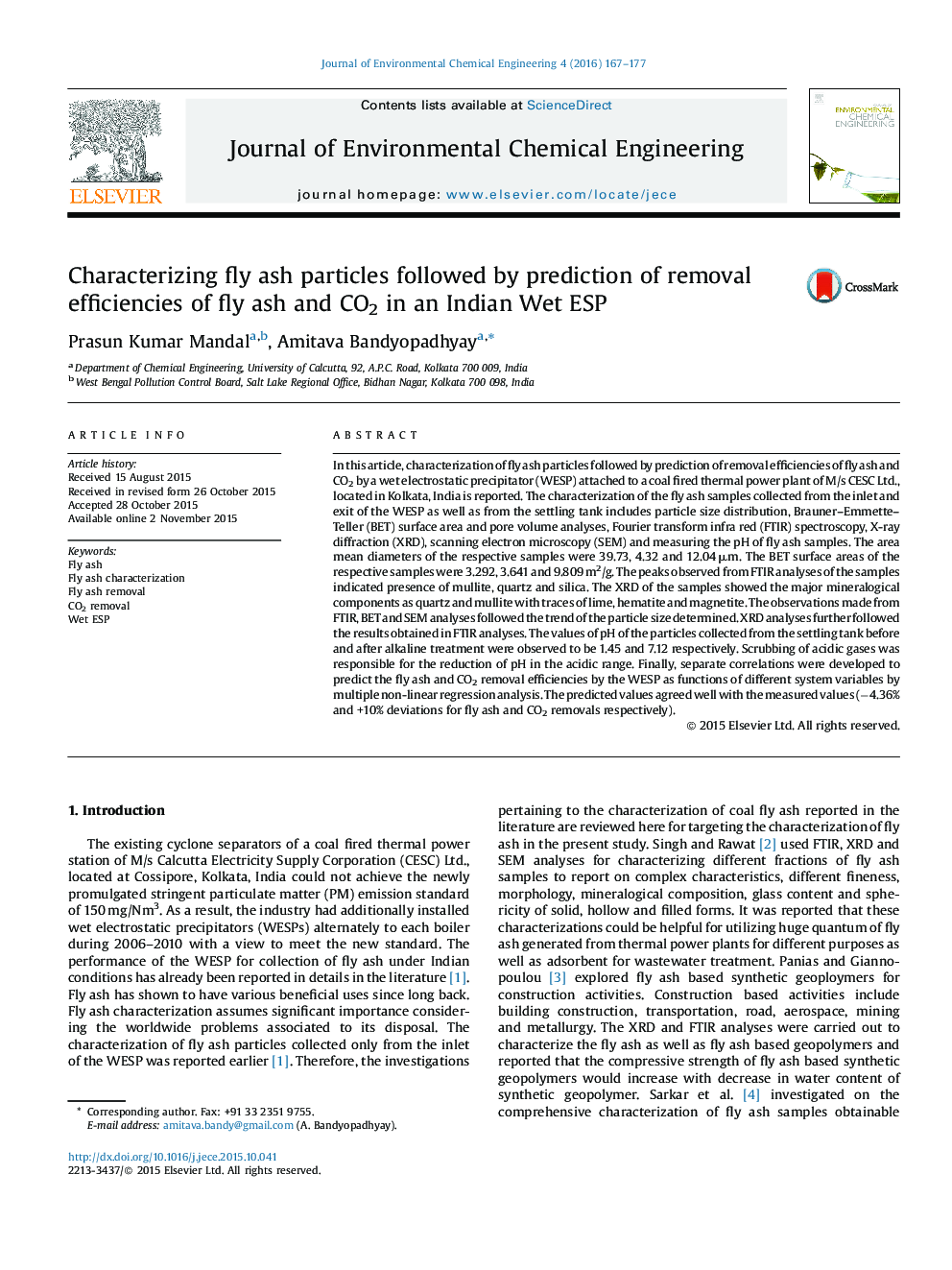| کد مقاله | کد نشریه | سال انتشار | مقاله انگلیسی | نسخه تمام متن |
|---|---|---|---|---|
| 221872 | 464267 | 2016 | 11 صفحه PDF | دانلود رایگان |
• Fly ash collected from an Indian coal fired thermal power plant deploying WESP are characterized.
• Characterization of fly ash includes analyses by particle size distribution, BET, FTIR, XRD, SEM analyses and measuring the pH.
• Observations of FTIR, BET and SEM analyses followed the particle size determined, while XRD analyses followed the results obtained in FTIR analyses.
• The overall fly ash collection efficiency and CO2 removal efficiency are predicted through correlations developed from dimensional analyses.
• The correlations are statistically highly significant.
In this article, characterization of fly ash particles followed by prediction of removal efficiencies of fly ash and CO2 by a wet electrostatic precipitator (WESP) attached to a coal fired thermal power plant of M/s CESC Ltd., located in Kolkata, India is reported. The characterization of the fly ash samples collected from the inlet and exit of the WESP as well as from the settling tank includes particle size distribution, Brauner–Emmette–Teller (BET) surface area and pore volume analyses, Fourier transform infra red (FTIR) spectroscopy, X-ray diffraction (XRD), scanning electron microscopy (SEM) and measuring the pH of fly ash samples. The area mean diameters of the respective samples were 39.73, 4.32 and 12.04 μm. The BET surface areas of the respective samples were 3.292, 3.641 and 9.809 m2/g. The peaks observed from FTIR analyses of the samples indicated presence of mullite, quartz and silica. The XRD of the samples showed the major mineralogical components as quartz and mullite with traces of lime, hematite and magnetite. The observations made from FTIR, BET and SEM analyses followed the trend of the particle size determined. XRD analyses further followed the results obtained in FTIR analyses. The values of pH of the particles collected from the settling tank before and after alkaline treatment were observed to be 1.45 and 7.12 respectively. Scrubbing of acidic gases was responsible for the reduction of pH in the acidic range. Finally, separate correlations were developed to predict the fly ash and CO2 removal efficiencies by the WESP as functions of different system variables by multiple non-linear regression analysis. The predicted values agreed well with the measured values (−4.36% and +10% deviations for fly ash and CO2 removals respectively).
In this article, characterizations of the fly ash particles collected at the inlet and at the outlet of the WESP as also from the collection tank before and after alkaline (dilute NaOH) treatment are reported. The characterization includes analyses by particle size distribution, BET, FTIR, XRD, SEM analyses and measuring the pH of fly ash samples collected at various sources by making slurry in distilled water. XRD analyses further followed the results obtained in FTIR analyses. The observations made from FTIR, BET and SEM analyses followed the particle size determination. Collected fly ash particles by the WESP showed acidic pH perhaps due to the scrubbing of acidic gases present in the flue gas. After the characterization, the scrubbing as well as electrostatic action by the WESP has been investigated in terms of removal efficiencies of fly ash and CO2. Finally, the overall fly ash collection efficiency and CO2 removal efficiency are predicted through correlations developed from dimensional analyses. The correlations for predicting the fly ash collection efficiency (correlation coefficient of 0.9917; −4.36% deviation) and for predicting the CO2 removal efficiency (correlation coefficient of 0.9692; +10% deviation) were statistically highly significant.Figure optionsDownload as PowerPoint slide
Journal: Journal of Environmental Chemical Engineering - Volume 4, Issue 1, March 2016, Pages 167–177
